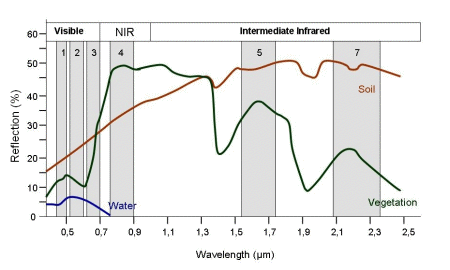1. Physical Basics
Spectral Reflectance Properties
Remote sensing is based on the measurement of reflected or emitted radiation from different bodies. Objects having different surface features reflect or absorb the sun's radiation in different ways. The reflectance properties of an object depend on the particular material and its physical and chemical state (e.g. moisture), the surface roughness as well as the geometric circumstances (e.g. incidence angle of the sunlight). The most important surface features are colour, structure and surface texture.
These differences make it possible to identify different earth surface features or materials by analysing their spectral reflectance patterns or spectral signatures. These signatures can be visualised in so called spectral reflectance curves as a function of wavelengths. The figure in the right column shows typical spectral reflectance curves of three basic types of Earth features: green vegetation, dry bare soil and clear water.
The spectral reflectance curve of healthy green vegetation has a significant minimum of reflectance in the visible portion of the electromagnetic spectrum resulting from the pigments in plant leaves. Reflectance increases dramatically in the near infrared. Stressed vegetation can also be detected because stressed vegetation has a significantly lower reflectance in the infrared.
More about spectral signatures of vegetation can be found in the tutorial Remote Sensing and GIS in Agriculture.
The spectral reflectance curve of bare soil is considerably less variable. The reflectance curve is affected by moisture content, soil texture, surface roughness, presence of iron oxide and organic matter. These factors are less dominant than the absorbance features observed in vegetation reflectance spectra.

Source: Siegmund, Menz 2005 with modifications
The water curve is characterised by a high absorption at near infrared wavelengths range and beyond. Because of this absorption property, water bodies as well as features containing water can easily be detected, located and delineated with remote sensing data. Turbid water has a higher reflectance in the visible region than clear water. This is also true for waters containing high chlorophyll concentrations. These reflectance patterns are used to detect algae colonies as well as contaminations such as oil spills or industrial waste water (more about different reflections in water can be found in the tutorial Ocean Colour in the Coastal Zone).
